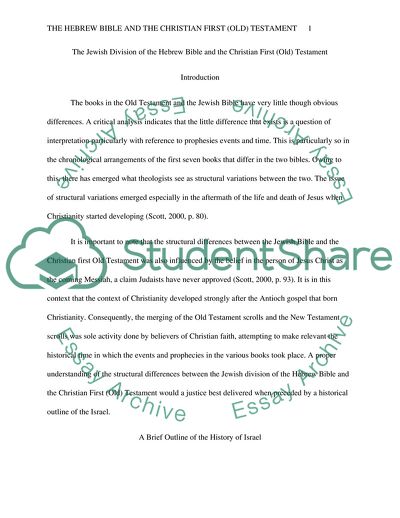Cite this document
(The Jewish Division of the Hebrew Bible and the Christian First Testament Book Report/Review Example | Topics and Well Written Essays - 1750 words, n.d.)
The Jewish Division of the Hebrew Bible and the Christian First Testament Book Report/Review Example | Topics and Well Written Essays - 1750 words. https://studentshare.org/religion-and-theology/1805529-critically-discussstructural-variations-exist-between-the-jewish-division-of-the-hebrew-bible-and-the-christian-firstold-testament
The Jewish Division of the Hebrew Bible and the Christian First Testament Book Report/Review Example | Topics and Well Written Essays - 1750 words. https://studentshare.org/religion-and-theology/1805529-critically-discussstructural-variations-exist-between-the-jewish-division-of-the-hebrew-bible-and-the-christian-firstold-testament
(The Jewish Division of the Hebrew Bible and the Christian First Testament Book Report/Review Example | Topics and Well Written Essays - 1750 Words)
The Jewish Division of the Hebrew Bible and the Christian First Testament Book Report/Review Example | Topics and Well Written Essays - 1750 Words. https://studentshare.org/religion-and-theology/1805529-critically-discussstructural-variations-exist-between-the-jewish-division-of-the-hebrew-bible-and-the-christian-firstold-testament.
The Jewish Division of the Hebrew Bible and the Christian First Testament Book Report/Review Example | Topics and Well Written Essays - 1750 Words. https://studentshare.org/religion-and-theology/1805529-critically-discussstructural-variations-exist-between-the-jewish-division-of-the-hebrew-bible-and-the-christian-firstold-testament.
“The Jewish Division of the Hebrew Bible and the Christian First Testament Book Report/Review Example | Topics and Well Written Essays - 1750 Words”. https://studentshare.org/religion-and-theology/1805529-critically-discussstructural-variations-exist-between-the-jewish-division-of-the-hebrew-bible-and-the-christian-firstold-testament.


